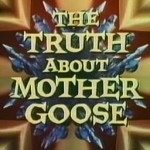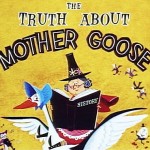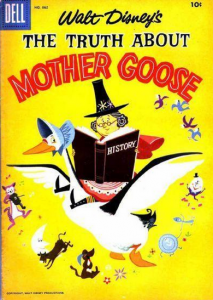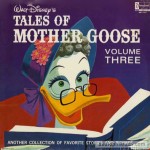A few years after the release of Disney’s Oscar-nominated featurette, Disneyland Records produced a fascinating album using portions of the Bill Peet script.

Walt Disney Presents
MOTHER GOOSE RHYMES AND THEIR STORIES
Told and Sung by Rica Moore
Disneyland Records Storyteller Series ST-3949 (12” 33 1/3 RPM LP & 11-Page Book)
Released in February, 1969. Executive Producer: Jimmy Johnson. Producer/Arranger: Camarata. Writers: Bill Peet, Jimmy Johnson. Harpsichord Soloist: Amidav Aloni. Running Time: 38 minutes. (Originally Released in 1963 as “Tales of Mother Goose Volume Three” DQ-1247.)
Rhymes & Stories: “Ride a Cock Horse,” “Humpty Dumpty,” “Betty Botter,” “Little Tom Tucker,” “Rock-a-Bye Baby,” “Dance to Your Daddy,” “Doctor Foster,” “Georgie Porgie,” “Dame Get Up,” “Oh Dear What Can the Matter Be,” “Jack and Jill,” “Little Miss Muffet,” “Little Nut Tree,” “Buff Says Buff,” “Over the Hills,” “London Bridge,” “Polly Put the Kettle On,” “Pussy Cat, Pussy Cat,” “Yankee Doodle.”
Other Features: “Betty Botter (Tongue Twister), “Two Riddles,” “Home Town Rhythm Band-Yankee Doodle” (from DQ-1225, “More Mother Goose”; added to ST-3949 only).
 The two-reel theatrical short, The Truth About Mother Goose, (1957, originally released paired with the True-Life Fantasy, Perri) was a tuneful look at the background histories behind three nursery rhymes: “Little Jack Horner,” “Mary Mary Quite Contrary” and “London Bridge.” Directed by Wolfgang Reitherman and Bill Justice with an alternately bouncy and symphonic George Bruns score, it’s a marvelous and underrated film from Disney’s UPA-look era, offering a unique twist on the familiar: These cute little rhymes aren’t quite what they seem.
The two-reel theatrical short, The Truth About Mother Goose, (1957, originally released paired with the True-Life Fantasy, Perri) was a tuneful look at the background histories behind three nursery rhymes: “Little Jack Horner,” “Mary Mary Quite Contrary” and “London Bridge.” Directed by Wolfgang Reitherman and Bill Justice with an alternately bouncy and symphonic George Bruns score, it’s a marvelous and underrated film from Disney’s UPA-look era, offering a unique twist on the familiar: These cute little rhymes aren’t quite what they seem.
The film was presented with “Mickey and the Beanstalk” (from Fun and Fancy Free) on Walt Disney’s Wonderful World of Color in 1963, with Professor Ludwig Von Drake replacing Edgar Bergen and John Dehner, respectively, as narrators.
A few months later, Disneyland Records released an album featuring the story behind “London Bridge” plus 18 other rhymes and stories called Tales of Mother Goose, Volume Three. This title is misleading because the label’s first two Mother Goose albums were traditional collections of rhymes and songs. The first featured Sterling Holloway and the second paired Ginny Tyler and Robie Lester. This is really not a third installment as it is a completely different approach that better suits older children and adults rather than preschoolers.
 There are two reasons why this album skews older. One is the very nature of the back stories, which are a bit more mature. Not HBO mature, to be sure, but pretty juicy just the same. We learn that “Georgie Porgie” is actually a risqué little ditty about adulterous womanizer George Villiers, Duke of Buckingham. “Oh Dear, What Can the Matter Be?” was inspired by a traveling circus performer who made empty promises to a young lady.” “Little Nut Tree” concerns a gift from Prince Philippe, Dauphin of France, to a Spanish Princess upon their first meeting about their arranged marriage.
There are two reasons why this album skews older. One is the very nature of the back stories, which are a bit more mature. Not HBO mature, to be sure, but pretty juicy just the same. We learn that “Georgie Porgie” is actually a risqué little ditty about adulterous womanizer George Villiers, Duke of Buckingham. “Oh Dear, What Can the Matter Be?” was inspired by a traveling circus performer who made empty promises to a young lady.” “Little Nut Tree” concerns a gift from Prince Philippe, Dauphin of France, to a Spanish Princess upon their first meeting about their arranged marriage.
Other rhymes have historical and political contexts. “Ride a Cock Horse” is really about the journey of Queen to Banbury on a highly decorated horse. “Humpty Dumpty” is a reference to the death of corpulent King Richard III. “Doctor Foster” is actually King Edward I. “Little Tom Tucker” is about beggars known as Tom Tuckers. “Rock-a-Bye Baby’s” history goes back to pilgrim days.
 The other reason that this album isn’t a garden variety “kiddie record” (a questionable term in itself) is its narration by singer/actress Rica Owen Moore—whose credits include a long stint with the Ray Conniff Singers and previous success on Disney records, including the long-selling mathematics albums with Jiminy Cricket. Moore’s approach is the very opposite of patronization—straightforward which touches of sly flippancy, as if she’s just dishin’ to close friends about the ol’ Goose.
The other reason that this album isn’t a garden variety “kiddie record” (a questionable term in itself) is its narration by singer/actress Rica Owen Moore—whose credits include a long stint with the Ray Conniff Singers and previous success on Disney records, including the long-selling mathematics albums with Jiminy Cricket. Moore’s approach is the very opposite of patronization—straightforward which touches of sly flippancy, as if she’s just dishin’ to close friends about the ol’ Goose.
The 1963 album was repackaged as a Storyteller book and LP set and retitled Mother Goose Rhymes and Their Stories. For the book, artist Harry Wysocki created impressive paintings in a sophisticated folk art style harkening back to the 1957 cartoon—though neither LP release actually mentions the film, except through the presence of black-and-white stills on the 1963 back cover.
 Perhaps to add some perceived value to the 1969 Storyteller version (or to make it more child-friendly), one added track starts off the disc: Ginny Tyler talking and singing about the “Play at Home Rhythm Band.” This is an excerpt from More Mother Goose, where is sounds right at home. But on Mother Goose Rhymes and Their Stories, this segment starts the album off on the wrong note, so to speak. Tyler had been directed to communicate to a much younger audience than Moore was, so the two just don’t blend. Hearing this at the beginning of the album gives an incorrect impression about the other 90% to follow.
Perhaps to add some perceived value to the 1969 Storyteller version (or to make it more child-friendly), one added track starts off the disc: Ginny Tyler talking and singing about the “Play at Home Rhythm Band.” This is an excerpt from More Mother Goose, where is sounds right at home. But on Mother Goose Rhymes and Their Stories, this segment starts the album off on the wrong note, so to speak. Tyler had been directed to communicate to a much younger audience than Moore was, so the two just don’t blend. Hearing this at the beginning of the album gives an incorrect impression about the other 90% to follow.
As in the film, Moore sings the traditional 19th melody, explains the story behind it and then sings it again, just like in the film. Since the “London Bridge” segment on the LP was taken from Bill Peet’s film script, one has to wonder if some or all of the others were also written by Peet but did not make it into the cartoon.
GIVE A LITTLE LISTEN
The Story of London Bridge
Almost word-for-word from the Peet script, this excerpt from Mother Goose Rhymes and Their Stories contains a humorous aside heard in the TV version with Ludwig Von Drake: the wisecrack about London Bridge being named “Charcoal Lane” after the fire (Von Drake called it “Charcoal Street”).



 GREG EHRBAR is a freelance writer/producer for television, advertising, books, theme parks and stage. Greg has worked on content for such studios as Disney, Warner and Universal, with some of Hollywood’s biggest stars. His numerous books include Mouse Tracks: The Story of Walt Disney Records (with Tim Hollis). Visit
GREG EHRBAR is a freelance writer/producer for television, advertising, books, theme parks and stage. Greg has worked on content for such studios as Disney, Warner and Universal, with some of Hollywood’s biggest stars. His numerous books include Mouse Tracks: The Story of Walt Disney Records (with Tim Hollis). Visit 





















































I recall the one Mother Goose Rhyme, Mary Mary Quite Contrary was based on Mary, Queen of Scots. And I was surprised that Georgie Porgie was based on the adulterous womanizing George Villers Duke of Buckingham.
While the Disney short attributed “Mary Mary Quite Contrary” to Mary, Queen of Scots, and it’s a very entertaining short BTW, I heard elsewhere that the Nursery Rhyme was about Bloody Mary instead.
I love how the Mary, Queen of Scots cartoon doesn’t hide the fact that this Mary did not have a Disney happy ending.
I had forgotten that John Dehner narrated THE TRUTH ABOUT MOTHER GOOSE. I wish this good, durable actor had penned a little essay about his early experiences as an animator at Disney.
Though Greg presented Joh and Edgar Bergan in reserve order..:) I forgot about the record (the last one)..I used to have that one as well…
Thank you for this elaborate description, Mr.. Ehrbar! I did not see THE TRUTH ABOUT MOTHER GOOSE when it was in theaters (though I am old enough that I *could* have). My introduction to it was via the TV airing. I did not buy the related lps, but I DID buy the comic book (and still have it to this day). This famous background to nursery rhymes fascinated me from the first time that I saw it!
I used to see the short when it appared on The Disney Channel a number of times in the 80’s and felt the same way at finding out these truths mentioned. It was an eye-opener to those of us who never questioned the meaning behind London Bridge or Little Jack Horner. Never had this LP though.
On Mickey and the Beanstalk didn’t Sterling Holliway (who did the story telling on Lambert the Sheepish Lion,Susie the Little Blue Coupe and starred in Alice in Wonderland and Winnie the Pooh) lend his voice as storyteller for the animated short?
It’s very possible that there was a version of Mickey and the Beanstalk with Sterling Holloway in place of Edgar Bergen, since the short film alone would have had to have a live-action intro with Bergen and his characters to explain who was talking. I don’t have the story alone on a VHS, as it was once released, but I’ll bet it was done with Holloway for 16mm and so forth so it could stand alone.
I believe that a version with Holloway narration was created in 1955 for the Disneyland show “The Adventures of Mickey Mouse”.
Hi guys, I dont post often, but I just had to say: OMG!!!! I was just recently thinking about this album and how I would never be able to find it. I had no idea it was Disney! These were some of my earliest memories, that’s for sure, and my first foray into using technology (a record player is pretty high tech for a three year old) Good Gods, the artwork! I remember listening to that album for hours. I love how they just dont sing the songs, they take time to give you a history, too.
It is interesting to think how Disney was part of my life without me even realizing it. Astounding.
Is there any chance there is a full recording online of the album? I have been looking.
Thank you again for your post! Just mind blowing how memories work like that!
Does anyone know the artist who illustrated the cover for ‘Tales of Mother Goose Volume Three’? It’s such a bold and strikingly lovely rendering. One of my all-time favorite Disney LP covers. Others include the Golden Records’ release, ‘Donald Duck Cowboy’ and the Disneyland Records’ release, ‘Alice in Wonderland’ soundtrack by Camarata – I think that one was done by Al Dempster.)